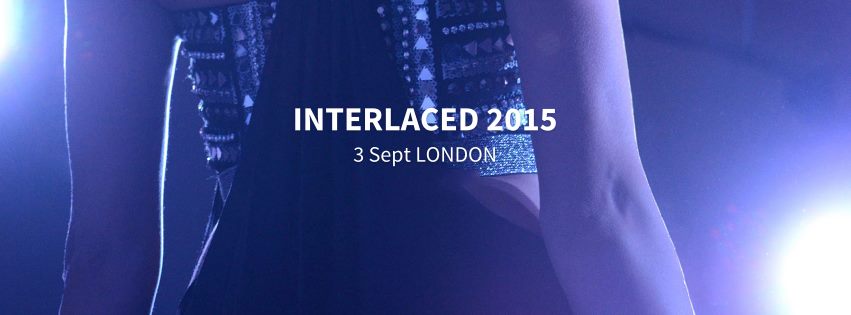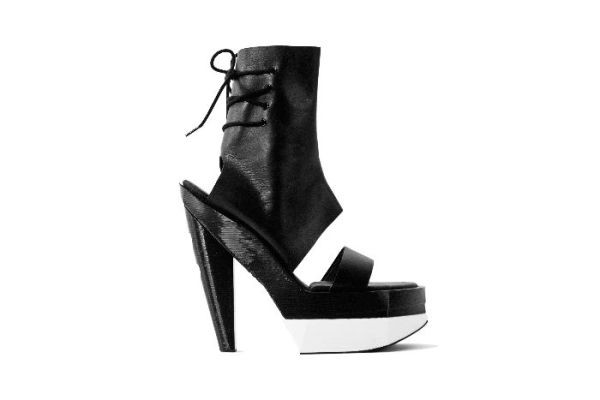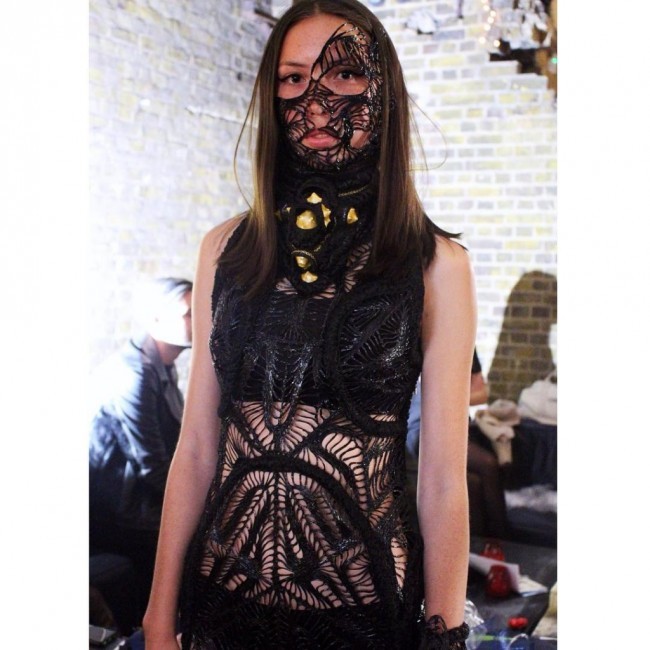Interlaced – An introspection in the FashionTech industry and the role of 3D printing
Posted By Claire Chabaud on Sep 16, 2015 | 0 comments
Interlaced is a FashionTech show. But it is more than a simple presentation of fashion industry designers. It is above all the meeting of investors, engineers, teachers, PhD student, influencers and even doctors who gather in order to discuss the challenges relating to the future of the clothing. 3D printing was, of course part of this event and was discussed from a business point of view.
The Demand Side of the FashionTech Market
The Supply Side of the FashionTech Market
The place of 3D printing in FashionTechnMarket
The Demand Side of the FashionTech Market
- Camille Baker – The Demand is not ready yet.
Camille Baker is a lecturer at the University for the Creative Arts in Digital Media and the founder of Bitch Stitch Make/Perfom group in London, a really active fashion-tech community. When Discussing the emergence of the FashionTech market, she had this striking observation:
“We have to wait for the demand to rise, because for the moment there is no need.”
This remark pointed out that this event wasn’t approaching FashionTech as a mere trending phenomenon but also as a business. Even if this comment must have disappointed some enthusiasts, it was objective & true. When talking about the FashionTech market, one should always consider that we are preparing a future market which doesn’t have a strong enough demand yet.
Education about wearable technology also has been approached. “I am in a university that has three or four strong fashion courses but they aren’t focused on wearable technology”. Universities are always slow to embark on new roads, she thinks.
“It takes time because you have to find experts, and they have to be the people who are on the edge. But actually, these people are either busy making money or trying to get their research recognised, and then it takes time to convince a university that a course is going to bring in students. Universities are businesses too and they need to know if they are going to make any money with this course.”
At Sculpteo we share this vision regarding importance of Education to the new technology and especially in 3D printing
- Connor Farrington – FashionTech when Fashion and medicine will be interlaced
Connor Farrington is part of Cambridge Centre for Health Services Research (CCHSR) and his speech was one of the most unexpected and interesting about the purpose of medicine in fashion. He asked an opened question about the way individuals express their personality through their clothing :
“Is it you, or someone else you are expressing?”
This comment was introducing the possibilities that FashionTech and 3D printing will allow, but also their limits. FashionTech may be the means to collect data on ourselves in a unique way, we are all things considered all unique. This data will allow us to express our personalities through the production means afforded by 3D printing.
One must nonetheless keep in mind both the importance of data security and privacy, on the one hand, and the risk of us becoming “data slaves”, on the other. For example, would a person that is terminally ill truly be willing to wear clothes that constantly remind them of their illness?
The Supply Side of the FashionTech Market
- Bryan Oknyansky, Faith Robinson and Roberta Luca – The Game Changing Potential of 3D Printing in Fashion.
The first aspect approached by Bryan Oknyansky, founder of shoesbybryan, was the problem of the product look. When he created his first 3D printed shoe, people where critical of its plastic aspect. They needed and wanted to be reeducated to touch. This will be a major challenge of 3D printing in this industry, the education of people to this technology. The game changing potential of 3D printing in Fashion will be mainly correlated on how customer expectation is changing.
But they remind us that “Technology is just another material” .
3D printing is a process of manufacturing, not a product in itself. In 20 years from now, 3D printing will be democratized in the fashion industry, then a product based only on this technology will have lost its “ hype” value. When Faith asked Roberta, founder of Wonderluk, and Bryan what they would do if they would have just discover 3D printing, they both answered:
“ I would totally graduate in 3D printing”
Highlighting again the importance of the education to stimulate the emergence of 3D printing and the knowledge of this technology by the consumers. If you are looking for a 3D printing education in Engineering, have a look to our first Ebook – Graduate in 3D printing.
- Amalia Agathou, Piers Ridyard, David Norris & Chris Chabot – How invest in FashionTech?
David Norris, Venture Capitalist at Forward Partners, and Chris Chabot, Venture Capitalist at Fiedler Capital explained how to convince an investor and what are they looking for when they evaluate a project. They estimate the people’s risk (are the founders fighting? do they seem reliable?), the product risk (is the product answering a need?) and the market risk. David Norris said:
“ You have to know your client, to understand his real needs through research and observations. But the most important is to spend time with him and get to know its habits”
Yes to innovation, but innovation is defined as technical progression that leads product that CAN actually be sold. Also Piers Ridyard, CEO at Nifty Drives, pointed out that in the case of a start up using a new technology it was important to have a high working capital meaning that the suppliers will be paid at the end allowing the project to be partially self-financed.
- Marianne Caroline Hugues – The need of a sustainable fashion: 3D printing as a solution ?
Fashion is the second most polluting industry just behind the oil industry. A ranking, which speaks for itself. This pollution is mainly due to the current manufacturing process. A point, that makes 3D printing and its eco-friendly materials, a reliable and relevant manufacturing process to consider for the near future.
The place of 3D printing in FashionTech Market
- Noémie Balmat – Introspection from a brand using 3D printing
Noémie Balmat, commercial manager at Exocet and founding editor at Clausette.cc gave us her insight on the future of 3D printing in the fashion industry.
According to you, what would the main challenges for a brand based on 3D printing be? ( in terms of retail and production)
First, I would say to secure its production: either the brand goes for a 3D printing company that it can trust, like Sculpteo, either they invest to do it themselves by buying their own printers – which requires know-how and funds. Then securing their designs, to avoid as much as possible being copied.
In terms of retail, I’d say it is important for each brand to have its own concept, based or not on the 3D printing. 3D printing is a solution to create one-of-a-kind objects, but it should not be at the center of your brand. The concept of your brand has to be more impactful than just basing it around 3D printing. Because more and more brands are going to use 3D printing, so differentiating your own from the competition is key to succeed in the market. Always remember 3D printing is an enabler, 3D printing is not your product.
Do you think fashion is ready for 3D printing ? If not, why?
I think Fashion is more than ready for 3D printing. Fashion always looks for ways to create new things, experiment new designs. Why not experimenting new production processes? 3D printing holds an unlimited number of possibilities in terms of creation, and in my mind this should be what fashion is looking for. Adding to that, we can now print in a bunch of different materials, not only just plastic but gold, silver and ceramics…
Fashion & 3D printing have been “dating” for a while now, from Iris van Herpen‘s gorgeous yet unwearable 3D printed dresses & shoes to Exocet’s avant-gardist yet more easily wearable bags, you can see a wide range of different ways to marry 3D printing and fashion. And it can also be used by consumers, to create their own designs or customise their clothes, and I really love this idea!
What are, in your opinion, the challenges facing the fashion of the future ?
The key challenges I see for the future of fashion can be listed in the following two categories:
– Sustainability (production): for our planet: how can fashion, as the second most polluting industry behind oil, repair or at least stop harming our natural home? & for Human rights: fashion is also responsible for too many catastrophies around the world,all in order for us “lucky westerners “to be “well dressed”. We have to find another way, find a way to respect local production and traditions, using technology to make people more aware of these challenges is a first step for change. I recommend you follow Marianne Caroline Hugues and her research for a more sustainable fashion future.
– Innovation (product, retail, advertising…): fashion brands have to invest in the future, and stop being so afraid of taking risks when they do. In my mind, fashion has always been an industry of experiments, searching for new ways to make people feel good in their clothes. So why are all fashion brands so afraid? Invest in the future!
According to you which technology would be really significant for the fashion industry ?
3D printing is of course a huge opportunity for the fashion industry, creating a wide range of new possibilities that we could not dream about before with the existing technologies.
But another technology that really impressed me is the Google Project Jacquard: providing the designers with fabrics incorporating conductive yarns, that they just need to design and work with; without needing an electronics background is simply amazing. Think about all the possibilities this promising project holds! I’m so excited about it that I can’t wait for the first projects using these fabrics to pop out!
Exclusive interview of Maartje Dijkstra, introducing its 3D printed dress by Clausette
This event, organized with a lot of enthusiasm by Kristina Dimitrova was a moment full of interesting encounters and a rich mix of people. It put forward many aspects of the fashion tech market such as the demand of the market, the supply of it; with the process from the creation to the realization, the new sustainable challenges and the right way to start a business, with the question of brand image and retail, and the consideration of the new ethical limits implied by the development of fashion tech. Not only focused on 3D printing, however this event was key to understand the fashion industry context in which 3D printing will be for sure an important role to play.


 Connect with Google
Connect with Google Connect with Facebook
Connect with Facebook


